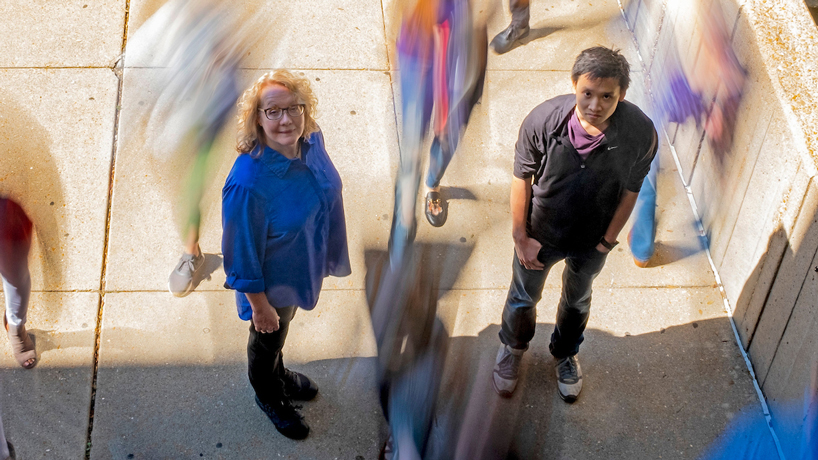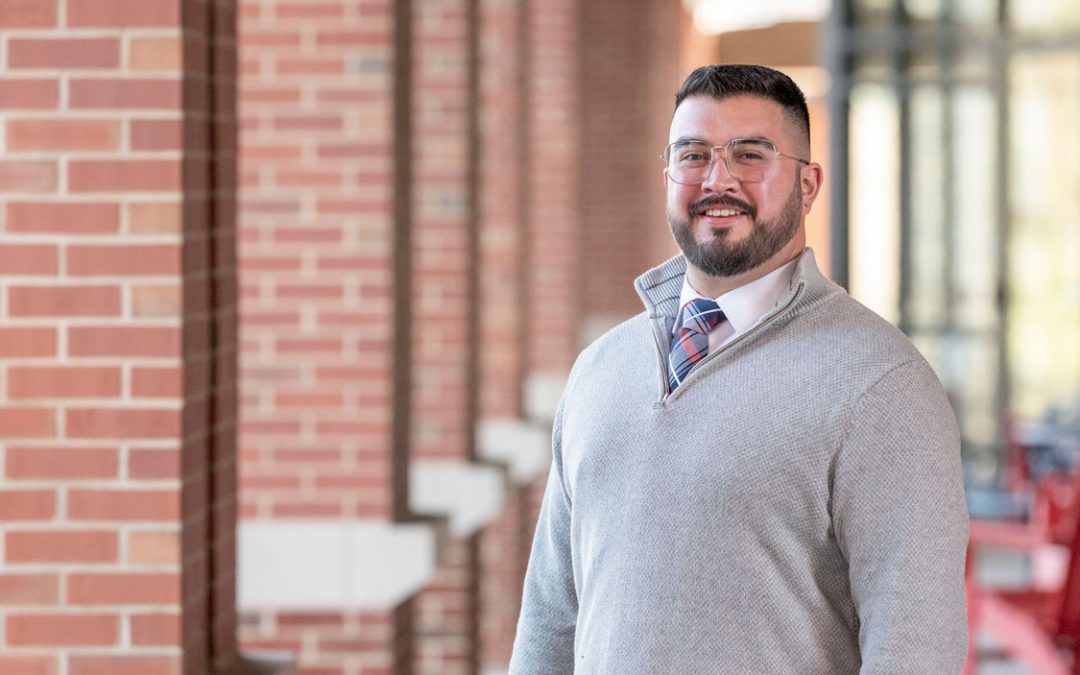
Assistant Professor Sharlee Climer and graduate research assistant Michael Chan have been using computational biology to try to unlock the biological secrets of Alzheimer’s hidden inside genetic code. (Photo by August Jennewein)
Sharlee Climer has witnessed firsthand the devastating effects of Alzheimer’s disease.
She’s seen the memory lapses and inability of a patient to reason through and perform what were once simple tasks, like sorting pairs of socks. She also observed the depression, irritability, social withdrawal and delusions that ultimately occur as the disease ravages the brain, robbing it of basic function.
Climer, an assistant professor of computer science at the University of Missouri–St. Louis, watched it all while living with and helping care for her mother-in-law, Muriel Climer, during the final stage of her life.
“It’s a horrendous disease,” Climer says. “It’s horrible. Just devastating.”
Muriel had been known for her soft smile and encouraging words throughout decades of work in the cafeteria at St. Louis Community College– Meramec. She was also a helpful and understanding landlord, who sometimes let months of rent slip when her tenants hit hard times.
“It was an extraordinary injustice that such a sweet soul was relentlessly tortured throughout her twilight years,” Sharlee Climer says.
Her motivation, then, was never merely professional when she first began using her expertise in computational biology to try to unlock the biological secrets of Alzheimer’s hidden inside genetic code.
“That’s why I got thinking that I want to do something,” Climer says. “It’s the one disease researchers have not gotten any closer to being able to prevent, treat or slow. It’s such an enigmatic disease. That’s what got me started on it.”
Climer believes that if she can discover which genetic markers are most closely correlated to individuals with Alzheimer’s, she will be able to help point researchers toward more effective treatments.
She has developed several computational methods to unearth patterns in the mountain range of available case-control data she examines. One is a program called BlocBuster, which identifies combinatorial correlations amongst genetic markers and determines carriers of these combinations, testing for associations between the combinations and instances of disease.
She has received $737,080 in funding for her lab over a five-year period from the National Institute on Aging as the co-primary investigator on a grant with Carlos Cruchaga at Washington University in St. Louis.
BlocBuster uses what Climer calls the Custom Correlation Coefficient during this three-step process to identify genetic patterns that had remained hidden using standard research methods. It has allowed her to spot different subsets at the genetic level of what appears to be a single disease at the clinical level.
Her code was adapted to take advantage of the computing power of Summit, the world’s most powerful supercomputer, under the direction of her colleague Dan Jacobson at Oak Ridge National Laboratory in Tennessee. In June, Summit broke the exascale barrier, exceeding a speed of a billion billion computations per second, while computing Climer’s metric. Earlier this month, that achievement won the team the Gordon Bell Prize, awarded annually to recognize outstanding achievement in high-performance computing.
BlocBuster revealed a “yin-yang” pattern in publicly available data that appears throughout global populations. Climer hopes discoveries such as this ultimately lead to better understanding of the genetic basis for the debilitating disease.
“This work’s also important for understanding your risk for disease,” Climer says. “If you have a combination of markers that put you at risk, you might do things differently in life. There are environmental factors that can have an effect in addition to your genetic risk, so people would be inclined to exercise more or whatever it is that would help reduce the risk of them getting the disease.”
Climer didn’t start out researching Alzheimer’s. In fact, when she was working toward her bachelor’s and master’s degrees in computer science at UMSL, she felt averse to biology.
“I didn’t want anything to do with it,” Climer says. “It involved too much new vocabulary. I studied physics and computer science, and they were perfect. They are always exactly right. Everything was clean. Biology’s messy. There are always exceptions to the rules.”
It was her doctoral adviser at Washington University who got her to open her mind to its possibilities when he presented her a problem cast as a mathematical linear program, the very kind she’d been developing software to solve.
She suddenly saw new possibilities in computational biology and became interested in learning more, taking biology courses on the side to build up her knowledge and vocabulary so she could communicate what she was seeing to biological researchers. Climer, in fact, has enough course credit to have a master’s in biology.
After finishing her PhD, Climer spent three years doing a postdoctoral fellowship in a lab at Washington University’s medical school. Her work focused primarily on investigating genetic patterns found in heart disease patients.
Climer eventually moved into a position as an assistant research professor at Washington University. Over time, her research emphasis also shifted to Alzheimer’s. That’s continued since Climer came home to UMSL – the school from which three of her children as well as her husband graduated.
“I love UMSL,” she says. “I feel like I really fit here. It’s a great place to be. The students have been wonderful.”
Climer’s work has benefited greatly from graduate researchers who’ve worked with her, including Michael Chan, who is slated to complete his master’s degree at UMSL this semester.
Chan has also taken a great deal from his involvement in the research.
“It’s introduced me to how you can apply computer science to a lot of different things,” Chan says. “It’s really nice to be able to apply what I’m learning to something that could potentially help a lot of people.”
This story was originally published in the fall 2018 issue of UMSL Magazine. If you have a story idea for UMSL Magazine, email magazine@umsl.edu.














